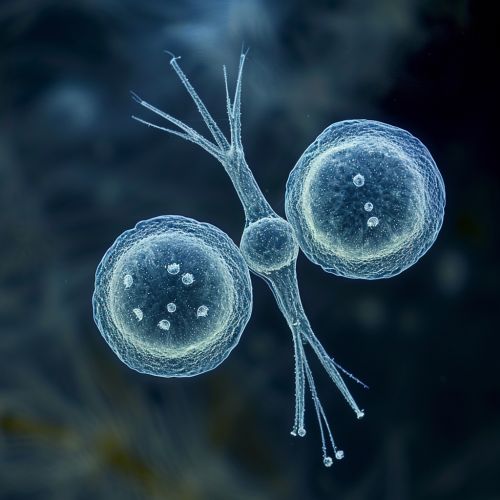Diplomonadida
Taxonomy and Classification
The Diplomonadida is a group of protists that belong to the supergroup Excavata. This group is characterized by the presence of two identical nuclei and multiple flagella. The Diplomonadida are further divided into two families: Hexamitidae and Enteromonadidae. The most well-known member of this group is Giardia lamblia, a parasite that causes giardiasis in humans.


Morphology
Diplomonads are small, typically 10-20 micrometers in length, and have a unique cellular structure. They possess two identical nuclei, each with four associated flagella, resulting in a total of eight flagella. These flagella are arranged symmetrically around the cell body, giving the organism a distinctive appearance. The cell body is often covered in a dense layer of surface proteins, which may play a role in host-parasite interactions.
Life Cycle
The life cycle of Diplomonadida is complex and varies among species. In the case of Giardia lamblia, the organism exists in two forms: the trophozoite and the cyst. The trophozoite is the active, feeding stage of the life cycle, while the cyst is the dormant, infectious stage. Transmission occurs when cysts are ingested by a host, either through contaminated water or food. Once inside the host's intestine, the cysts transform into trophozoites and begin to multiply. Eventually, some trophozoites transform back into cysts, which are excreted in the host's feces and can infect new hosts.
Ecology
Diplomonads are found in a variety of environments, from freshwater to marine environments, and even in the intestines of various animals. Some species are free-living, while others are parasitic. Parasitic species, like Giardia lamblia, can cause disease in their hosts. The ability of these organisms to form cysts allows them to survive in harsh environmental conditions, facilitating their transmission and spread.
Evolution
The evolutionary history of Diplomonadida is a topic of ongoing research. It is believed that these organisms are primitive eukaryotes, having diverged early in the history of eukaryotic life. Some evidence suggests that Diplomonadida may have evolved from a common ancestor with other Excavata groups, such as the Euglenozoa and Heterolobosea. However, this hypothesis is still under debate.
Pathogenicity
Certain species of Diplomonadida are known to be pathogenic. The most notable example is Giardia lamblia, which causes the disease giardiasis. Symptoms of giardiasis include diarrhea, abdominal pain, and nausea. The disease is typically treated with antiprotozoal drugs. Other less common diseases caused by Diplomonadida include hexamitiasis and spironucleosis.
Research and Studies
Research on Diplomonadida is primarily focused on understanding their biology, ecology, and evolution. This research is important for developing new treatments for diseases caused by these organisms, as well as for understanding the evolution of eukaryotic life. Recent studies have explored the genetic diversity of Diplomonadida, the mechanisms of cyst formation, and the role of surface proteins in host-parasite interactions.
